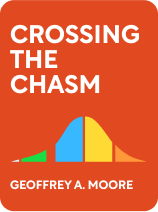

This article is an excerpt from the Shortform book guide to "Crossing the Chasm" by Geoffrey Moore. Shortform has the world's best summaries and analyses of books you should be reading.
Like this article? Sign up for a free trial here .
Have you ever wondered why so many high-tech products seem to make a sensational entrance, but then disappear before they’re refined enough to become practical? What is the reason why most new, high-tech products never reach the stage of maturity?
Adoption of new technology by the mainstream market doesn’t happen overnight. Further, most tech products will never see mainstream success. Marketing consultant Geoffrey Moore has an explanation for this: once the product is adopted by the early market of tech-savvy users, the sales stagnate as the mainstream market customers are not as keen on jumping on the new technology. Moore refers to this phenomenon as the “chasm” between the early market (innovators and early adopters) and the mainstream market.
In this article, we’ll explore the chasm phenomenon and look at Moore’s strategy for piloting a product across this chasm to mainstream success.
Most New, High-Tech Products Will Die in the Chasm
Periodically, a new high-tech innovation will transform the way we live or do business and propel its inventors to wealth and fame. In his book Crossing the Chasm, Moore argues that there’s a little-recognized gap or “chasm” in this model between the early market and the mainstream market—and failure to cross this gap accounts for the failure of many high-tech products.
To understand Moore’s strategy, you need to understand the chasm between the early and mainstream markets, and to understand the chasm, you need to understand the Technology Adoption Life Cycle (TALC), also referred to as the “diffusion of innovations.”
As Moore explains, the TALC predicts that as a technology matures, the number of potential new buyers first increases (as the technology starts to catch on) and then decreases (as you run out of potential customers who haven’t already bought it), following the profile of a bell curve. The area under the curve represents the total number of customers for the new technology. This area is divided into five categories of prospective customers, as shown in the figure below.
The Technology Adoption Life Cycle
To understand why mass adoption of new technology is so difficult to achieve, let’s take a look at the Technology Adoption Life Cycle (TALC). The TALC model divides customers into five categories based on their “psychographics,” the combination of psychology and demographics that dictates their purchasing behavior. These categories are:
Innovators
Innovators are the first to buy new technology. According to Moore, they love new technology just because it’s new technology, but they’re often on a limited budget because they usually work highly technical jobs, rather than positions in upper management.
(Shortform note: While Moore describes innovators as having limited budgets, Beal and Bohlen assert that innovators have high net worth and are typically influential people in their communities. Perhaps the difference arises from studying them in different contexts. An engineer working in industry might have a limited budget for assessing experimental technologies, while a self-employed farmer would only be able to experiment if he had the money to do so.)
Early Adopters
Early Adopters are the second group to buy new technology. According to Moore, early adopters are usually visionary business managers: They don’t value new technology for its own sake, but they have enough technical insight to identify the strategic advantages that new technology can provide.
(Shortform note: According to Beal and Bohlen’s original characterization, early adopters tend to be younger and more highly educated than members of the early and late majority, and are the most likely category to hold public office. Moore doesn’t mention these characteristics, which again may be a function of context: In a farming community of the 1950s, a college degree would make a farmer stand out as exceptionally educated, while in high-tech industries, almost everyone has an advanced degree. So too, perhaps early adopters in rural farming communities tend to be more involved in municipal politics, while early adopters in high-tech companies tend to be more involved in corporate politics.)
Early Majority
The Early Majority are the third group to adopt new technology. According to Moore, they are pragmatic people, who are interested in leveraging new technology to improve their business, but also averse to the risks of unproven technologies. They are less technically inclined than innovators or early adopters, and tend to measure a high-tech product more by industry standards and the product’s reputation than by direct assessment of the underlying technology.
(Shortform note: Beal and Bohlen emphasize that the early majority tend to have fewer resources than innovators and early adopters, and thus, cannot afford to take risks with unproven technology. Moore asserts not that they can afford risks less, but that they are less interested in taking risks unless they can see a clear benefit.)
Late Majority
The Late Majority are the fourth group to adopt new technology. According to Moore, they are more conservative and less technically competent than the early majority: They’re not interested in getting ahead with technology, but they don’t want to fall behind.
(Shortform note: Beal and Bohlen’s original characterization refers to this category simply as the “majority.” Perhaps, in their assessment, this group was larger than the early majority. Then again, they may just have been using the term “majority” in a cumulative sense, since after you pass the peak of the bell curve, a majority of total customers have adopted your product. The fact that Beal and Bohlen displayed their customer categories on an s-shaped cumulative distribution curve, instead of on the bell curve suggests that they may have been thinking in cumulative terms.)
Laggards
Laggards do not adopt new technology willingly. If they adopt it at all, it will be old technology by the time they do.
(Shortform note: Beal and Bohlen referred to this category as the “non-adopters.”)
The Chasms in the Technology Adoption Life Cycle
Moore explains that the traditional TALC assumes sales to the five categories of customers transition seamlessly from one to the other as the technology matures. However, according to Moore, this assumption is wrong. He argues that the psychographic differences between the people in each stage of adoption create gaps between each category.
By far the largest gap in Moore’s revised TALC is between the early adopters and the early majority. He refers to this gap as the “chasm.”
Moore explains that early adopters assess new technology at a technical level, to determine if it can give them a strategic advantage, whereas the early majority assess it based on its reputation and standardization. Because they value different things, the early majority won’t look to the opinions of early adopters when deciding whether to buy your product.
This creates a catch-22, because the early majority won’t buy your product until it has built up a good reputation in their industry, but your product can’t build up a good reputation until they start buying it and using it.
Geoffrey Moore: How to Cross the Chasm
How do you cross the chasm? At a high level, Moore’s strategy for crossing the chasm consists of focusing your efforts on becoming the market leader in a very specific niche market, then expanding into other niches until you dominate the market.
According to Moore, the reason this works is that it has an amplifying effect on marketing. He asserts that all marketing is ultimately dependent on word-of-mouth. Word of mouth spreads quickly through a small niche market: If just a few customers are impressed with your product, everyone will hear about it (whereas in a large market, their voices would be lost in the crowd). This is what makes it possible to build a reputation for your product and attract early-majority customers.
Example: Crossing the Chasm
As a hypothetical example to illustrate Moore’s strategy, imagine you have developed a revolutionary imaging technology for detecting defects in welds. When you reach the chasm, you decide to target inspection of welded pipe joints in nuclear submarines as your niche industry. This niche offers several advantages:
First, pipe joint failures in submarines tend to have disastrous consequences, as in the case of the USS Thresher. This gives your prospective customers a compelling reason to thoroughly inspect their pipe welds. Since your product makes it easier to assess weld quality, this also gives them a compelling reason to buy your product.
Second, the US Navy and its shipbuilding contractors are well funded. They can afford to buy your product.
Third, this industry is small and closely connected, since there are only a few shipyards in the United States that build nuclear submarines. As they start to realize the advantages of your new weld inspection probe, word will spread quickly.
Finally, once you dominante this niche, you’ll have access to adjacent market sectors. For one thing, you’ll have a foothold in the shipbuilding industry, allowing you to branch out into other weld-inspection venues at both naval and commercial shipyards.
For another thing, the stainless steel piping systems used in nuclear reactors are physically similar to the stainless steel piping systems used in food processing plants. Contractors specializing in welded stainless steel piping often provide services to both the nuclear industry and the food processing industry. Thus, inspecting pipe welds in nuclear naval vessels puts you in a position to branch out into inspecting pipe welds in food processing facilities as well.
In this way, by focusing on and dominating one small niche, you can, using Moore’s strategies, position your company to become a more mainstream provider of services to a wider swath of companies.

———End of Preview———
Like what you just read? Read the rest of the world's best book summary and analysis of Geoffrey Moore's "Crossing the Chasm" at Shortform .
Here's what you'll find in our full Crossing the Chasm summary :
- An explanation of the chasm phenomenon that many new high-tech products face
- How to pilot a product across this chasm to mainstream success
- The problems with the Technology Adoption Life Cycle (TALC) model






